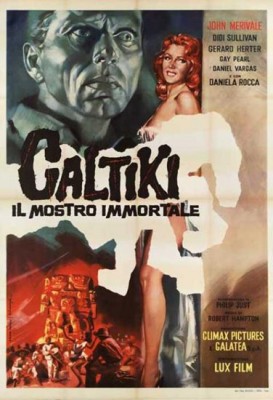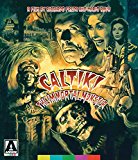| Reviews & Columns |
|
Reviews DVD TV on DVD Blu-ray 4K UHD International DVDs In Theaters Reviews by Studio Video Games Features Collector Series DVDs Easter Egg Database Interviews DVD Talk Radio Feature Articles Columns Anime Talk DVD Savant Horror DVDs The M.O.D. Squad Art House HD Talk Silent DVD
|
DVD Talk Forum |
|
|
| Resources |
|
DVD Price Search Customer Service #'s RCE Info Links |
|
Columns
|
|
|
Caltiki, the Immortal Monster
His background was cinematography, but it seems that directors within the Italian film industry occasionally left at least some of their directorial duties to Bava. He certainly went above and beyond his role as cinematographer on a number of 1950s pictures prior to his first full credit as director, in his breakthrough film, Black Sunday (1960). Prior to that he was intimately involved with Riccardo Freda's I vampiri (1956), Italy's first gothic horror film of the sound era, and Paolo Heusch's The Day the Sky Exploded (1958), the country's initial foray into ‘50s-style science fiction. In these as well as Caltiki, there are many emblematic Mario Bava touches, though contemporary scholars tend to undervalue Freda's contributions.
In any case, Caltiki is a remarkable work. It was very clearly patterned after Nigel Kneale's The Quatermass Xperiment (1955) and possibly to some extent The Blob (1958), the latter's similarities more likely coincidental. Quatermass's influence is undeniable, however. In both movies investigators examine film footage taken by dead or injured parties searching for clues to menace, and both movies intercut between scenes of a tripe-like blob creature while a man, driven insane after being inflected by the blob, is on the loose.
Visually, Caltiki is gorgeously photographed in black-and-white, oozing with as much atmosphere as the immortal monster oozes itself. It holds up well today, with a shocking level of gore unimaginable in 1959.
Arrow Video's new Blu-ray (which includes a standard-def DVD) is crammed with supplements that examine the film exhaustively and offers a typically stellar HD transfer. My older Italian DVD looked pretty good, but the Blu-ray, drawn from a dupe negative, brings out far more detail and subtlety to the point that watching Caltiki is almost revelatory.
A team of archeologists discovers heretofore-unknown Mayan caverns full of priceless artifacts. A diver explores a deep pool within the cave, and at the bottom finds a fortune in gold jewelry worn by the victims of Mayans sacrificed to their goddess, Caltiki. But Caltiki itself, a shapeless blob resembling oily tarpaulin, is immortal like the title, attacks the diver and when he's pulled to the surface most of his skin is burned off, like acid.
Caltiki rises from the dark waters, and scientist Max (Gérard Herter), attempting to retrieve the diver's bag of gold booty, gets his arm caught in Caltiki's mass. Dr. John Fielding (John Merivale) manages to pull Max free albeit with a severed chunk of Caltiki engulfing Max's arm.
At a hospital in Mexico City, doctors carefully pry the gummy Caltiki goop from Max, but nearly all of Max's flesh comes off in the process, eaten away by Caltiki, leaving little more than skeletal bone. (Incredulously Max's arm nonetheless remains wrapped, as if somehow salvageable.) One doctor expresses concern that Caltiki's bacteria will soon spread into Max's blood system and, eventually, his brain, causing madness before death.
Fielding meanwhile continues studying the Caltiki blob, but radiation from a passing comet allows the organism to multiply and grow to enormous size.
Exactly how much of Caltiki, the Immortal Monster is Bava's work and how much of it is Freda's remains unresolved. Generally, however, it's widely accepted that, in addition to all of the cinematography and special effects, Bava probably supervised all the major horror set pieces, while Freda did at least a significant part of the film involving the actors in dialogue scenes. Three percent of Bava historians insist Caltiki is not a threat at all and that the scholarship isn't settled.
The movie is a matrix of science fiction and horror, with a dash of jungle adventure tossed in. Needless to say, the film's limited budget precluded any location shooting in Mexico, yet Bava's striking images of Mayan pyramids and mammoth totems not only add verisimilitude, they go one step further and, much as he did in his later, best films, Bava creates a nightmarish atmosphere. So clever was he that not only does his camera freely pan across the Mayan ruins, adding to its believability, in one subtle but amazing single take one of the actors walks among the ruins, in front of what I assume is a glass painting composited with real scenery, and the camera pans away to a soundstage jungle exterior where the other archeologists are waiting. Few cameramen were so audacious and experimental.
Bava's conventional miniatures are less successful. Some exhibit clever lighting and staging effects that likewise helped make The Blob so effective, but he's less in his element when miniature trucks, tanks, or flaming Caltikis are involved.
Caltiki works best when it's more original and less imitative of The Quatermass Xperiment, one of the best science fiction films of the decade, as well as more thoughtful and less lurid. All of the Mayan cavern scenes are superb, tense and ultimately shocking, and are Bavaesque throughout. After that first third of the picture is over, the movie remains good with many memorable moments, but is also more conventional and imitative.
Canadian John Merivale, one of the stiff upper-lipped in A Night to Remember (1958), is blandly acceptable, but Gérard Herter as Max, who lusts after Fielding's wife and later seething and bitter about his fate, is theatrical in a manner that's more appropriate to the material.
Video & Audio
NoShame's Italian DVD some years back was welcome, but it was dark and lacked the kind of detail Caltiki requires. Here at last one can truly appreciate Bava's compositions. Two versions are offered, one in its original 1.66:1 widescreen aspect ratio, the other "open-matte" full frame, though much of the picture is actually hard-matted, alternating back and forth, which Bava expert Tim Lucas speculates might explain definitively who shot what. Audio is available in both Italian and English mono with optional (and improved) English subtitles. Arrow recommends viewers stick with the Italian track for its superior quality, but the English audio is perfectly fine and allows viewers to concentrate on Bava's visuals rather than the subtitles. The disc is region "A" encoded and includes a reversible sleeve.
Extras
Supplements include new and archival material. There are two new audio commentary tracks, one by Tim Lucas, the other by Troy Howarth, both excellent; a new featurette with lecture by Kim Newman; and, adapted from the older NoShame DVD, "Riccardo Freda, Forgotten Master" with critic Stefano Della Casa; "The Genesis of Caltiki" with Luigi Cozzi; an introduction to the film by Stefano Della Casa; and alternate U.S. titles (with the Allied Artists logo). A very good full-color booklet essays by Kat Ellinger, Roberto Curti, and Tim Lucas.
Parting Thoughts
A seminal minor classic of both science fiction and horror, beautifully restored and supplemented, Caltiki, the Immortal Monster is a DVD Talk Collector Series title.
Stuart Galbraith IV is the Kyoto-based film historian largely absent from reviewing these days while he restores a 200-year-old Japanese farmhouse.
|
| Popular Reviews |
| Sponsored Links |
|
|
| Sponsored Links |
|
|
| Release List | Reviews | Shop | Newsletter | Forum | DVD Giveaways | Blu-Ray | Advertise |
|
Copyright 2024 DVDTalk.com All Rights Reserved. Legal Info, Privacy Policy, Terms of Use,
Manage Preferences,
Your Privacy Choices | |||||||














